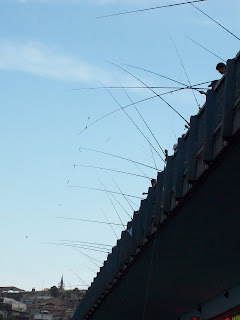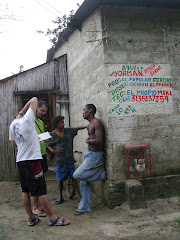



Stereotypes suggest that Buenos Aires is some sort of european enclave in south america. Some kind of urbanistic consistency, a feeling of european capital, a taste for arts, an old metro system that inspires nostalgy, bookshops and posters promoting union action, theatre plays or a new book, tango culture like an invisible bond between the old and the new world...Most things that mark a difference with the continent's big cities like Sao Paulo, Rio, Lima and Bogota.
Despite that, as the days grow longer in October, the city is once again on the verge of another political crisis. Today the parliament is voting the Media Law (which aims to reduce the influence of big private corporations on the audiovisual landscape), which president Cristina Kirchner is trying to force through at any cost, in the middle of a climate of extreme polarization, and a crucial football game that same night, which will decide whether or no Argentina will participate to the South African WorldCup!
Buenos Aires may have witnessed many days like this and others worse during its history. But the buses full of "militants" that came to "support the vote of this law " and generate huge gridlocks on the Avenue 9th of July, give mixed impressions. Here you will not find students longing to debate Chomsky's and Bourdieu's theories on the media, but rather herds of peones. Coming straight from the projects with no slogans nor signs, they don't look very versed in law and media maters, but more interested in body language and dynamite class firecrackers. Just add to it smoke and horns, and you'll see that yes, this is south america !
SOUTHERN SUBURB
In order to escape the Gotan Project video clip-like image of a velvet capital, we had asked Chancha Via Circuito, one of the distinguished members of the Zizek tribe which recently toured the US, and promotes worldwide its own revisited interpretation of cumbia villera, an argentinan projects version of columbian cumbia, to take us to his house. Heading to the meeting place, the printing workshop where he works downtown, one starts to imagine one of those hypish and coulourful characters that rock the blazé crowds in Hamburg ,Paris, NY. But the man is politely quiet. As soon as he finishes work, we rush together in the overcrowded metro for a dosis of daily routine in the huge argentinian capital. As we hit Constitucion train station, we catch the Genreal Roca line, formerly...Chancha via Circuito line ! Things start to get clearer!
The train rattles towards Lanus through extraordinarily anarchic and dirty shanty towns. Exhausted workers lie on the ground, clouds of marijuana drift out of the bike box (with no bikes in it) and the characteristic "chucucha" of the cumbia rhythm can be heard coing out of any of the headphones around. This is the typical suburbian "Che boluudoo" "wassup m2#@@#er" type of atmosphere. " Most of the cats here listen to cumbia villera, as you can hear. This is clearly not a music that rich people listen to. Its considered something for the masses and looked upon as such. The cumbia villera talks about hustlingm the barrio, just like hip hop would actually."
MYSTICAL FOLKLORE
Totally in harmony with that reality -he is the only one among the Zizek tribe to actually live in the remote southern suburbs- Chancha is entitled to talk about that music he knows so well, and sincerely appreciates. He marks his difference with the likes of Villa Diamante - the most popular dj of the Zizek tribe- whose work mainly consists in mash ups - a combination of a classic cumbia rhtyhm with a vocal track, as hypish and far from original cumbia as possible, be it Daft Punk or De la Soul...After all, if this genre is getting more and more popular on the club scene in Europe and the US, among the Argentinian middle class youth, where Missy Elliott could as well be a brand of lipstick, the reaction is not as significant.
The sun goes down on Jorge Marmol district, a sort of middle class low rise suburb bathed in the autumnal light of the austral spring. A group of teenagers sips Maté while chatting. It's here, in those little parks surrounded by houses and nice vacant lots, that Chancha and his singer girlfriend, Sol, come to play their neo folk made of strange noises, whispers and airy guitars. We are now far from the media buzz and the trendy european clubs and festivals.
Exactly what Chancha wants to escape from, as he seeks to create sound atmospheres that have strong references among the repertoire of bearded singers, far from the cumbia classics. The wonderful voices of mystic folklorists Leda Valladares and Jose Larralde haunt his new productions. "The new cumbia helps promote that kind of things among the young, even if you have to admit that the crowds that listen to the new cumbia now were never interested in folkloric music nor brought up to even appreciate it" point Sol and Chancha, sipping and passing a Mate at home " Nowadays there is a movement which consists in digging more in the folklore genre. Villa Diamante started to do mash ups of folklore. It's part of the same dynamic, right now pretty much everything from anywhere could be part of your musical options". But these reflections should not mislead us. Two days later, at a Mutek party in Club Niceto (the Montreal festival has a delocalized event in Buenos Aires) he showed again that once at the control, he moves the crowds like no one else can...
leave a comment if you want to read the rest













































